WHAT'S NEW ACROSS THE WORLD
Select date in side bar to go to a What's New of previous issues
| What's New
©by Laif DeMason
As 2017 draws to a close, hurricane-weary citizens hope for an improved 2018 to come. People from southeast Texas to Florida to Puerto Rica and several Caribbean islands are still trying to cope with what the 2017 hurricanes have brought. Long term power loss is obviously detrimental to aquarium fish keeping, among other things. Hurricane Irma was large enough to affect nearly the entire state of Florida. Unfortunately there are many tropical fish farms in Florida, especially on the western side that haven’t seen hurricane force winds in decades. While the losses of actual fish stocks were low, farm infrastructure such as greenhouses, pond covers, and bird exclusion net houses were heavily damaged or destroyed. Florida fish farmers are still left picking up the pieces and dealing with life afterwards.
Here’s “what’s new” on the cichlid scene: |
Lake Tanganyika
The long-standing interest in wild caught Tanganyika fishes has spurred on some new export companies in East Africa. Unfortunately the novice newcomers usually do not know what a detailed business it is to hold and ship live fish. In addition, despite the implications of some social media posts, the market is actually finite and not insatiable. All leading to direct sales to private hobbyists and smaller margins overall.
| WHAT'S NEW: LAKE TANGANYIKA |

Apparently all blue Cyprichromis microlepidotus are the rage now for “Cyps” in parts of the world. While the wild populations of these fish have both yellow-tail and blue-tailed individuals, the all blue male form can be found from Sibwesa to Karilani Island, Tanzania. Photo by A. Konings.
|

Several of the Cyprichromis species are popular among hobbyists. One such variety is the Cyp. sp. ‘jumbo leptosoma’ from Moba, Congo; otherwise known as “Moba Speckleback”. Since wild exports from this area usually consists of hardy fish like Cyphotilapia, fanciers of this Cyprichromis need to rely on fish from bred sources.
|

Originally collected on the Congo side of the lake, Neolamprologus marunguensis or “White Tip Brichardi” still commands strong sales to those who like these types of fish. Fortunately specialty breeders are happy to comply.
|

Neolamprologus pectoralis is a rarely caught and rarely imported fish from the Congo side of the lake. Occasionally one or two show up every few years. Not enough for any earnest breeding program. Hopefully one day more will appear and a few offspring will result.
|
Lake Malawi
The interest in adult Malawi cichlids is still on the upswing. Predatory and oddball haplochromines are especially of interest in China and America. On the other hand, small mbuna and any OB mbuna are in demand in Europe and China. Exporters are happy to comply.

Several of the torpedo-shaped haplochromine are quickly snapped up when imported. One such fish is Taeniochromis holotaenia, found hunting in pack in the lake. They are usually purplish gray in color. However, males develop a strong and beautiful yellow and blue coloration. Photo by A. Konings.
|

Reportedly from Makonde, Tanzania and a recent arrival, this small Lethrinops species is similar to L. auritus. This fish has blue facial marking along with yellow finnage and large egg spots. Who wants to see what this fish will color up to be?
|

Another unknown wild import of late has been this smallish Copadichromis species caught in northern Tanzania. Females sport one large mid-body black spot and orange finnage, leading to the belief that it is a C. pleurostigma type species.
|

From Nsisi, Tanzania north of Makonde, the so-called “Imperial Tiger Steveni” which is often confused by many Malawi exporters. The fish sports two orange-yellow patches on the male’s girdle and upper shoulder areas and is a heavier bodied “Steveni” type related more to Protomelas taeniolatus.
|

Many of the Pseudocrenilabrus species are popular and bred by hobbyists. Pictured here Ps. philander, is one of the smaller species and is a maternal mouthbrooder. Usually aquarium breeding is not a problem. Photo by O. Lucanus.
|

Seemingly some of the shipping logistics have been finally worked out for fishes from the Democratic Republic of Congo to the USA. With this in mind, more cichlids like Orthochromis stormsi and others will be available. Photo by O. Lucanus.
|
Select date in side bar to go a What's New of previous issues |









